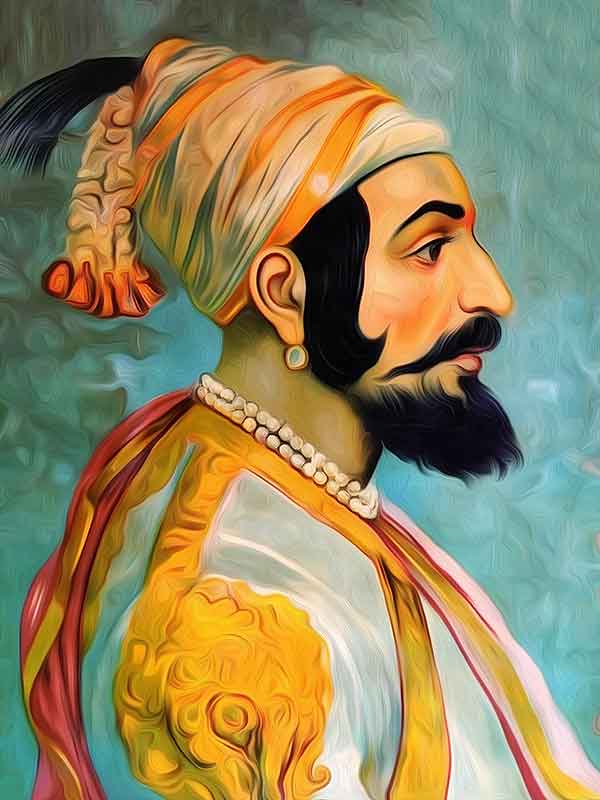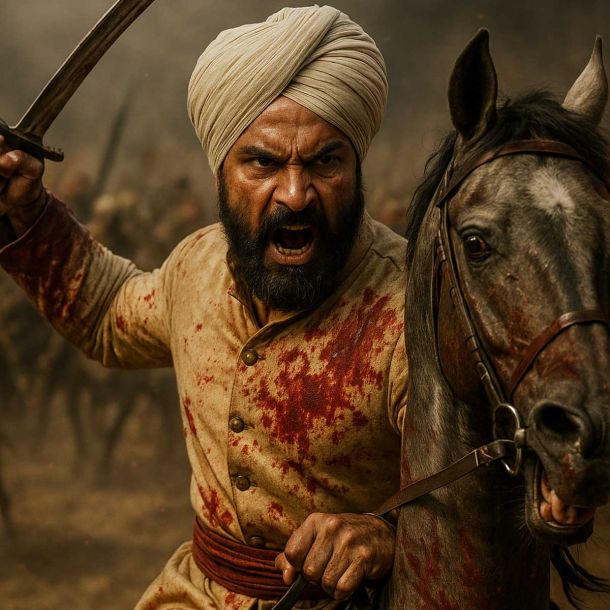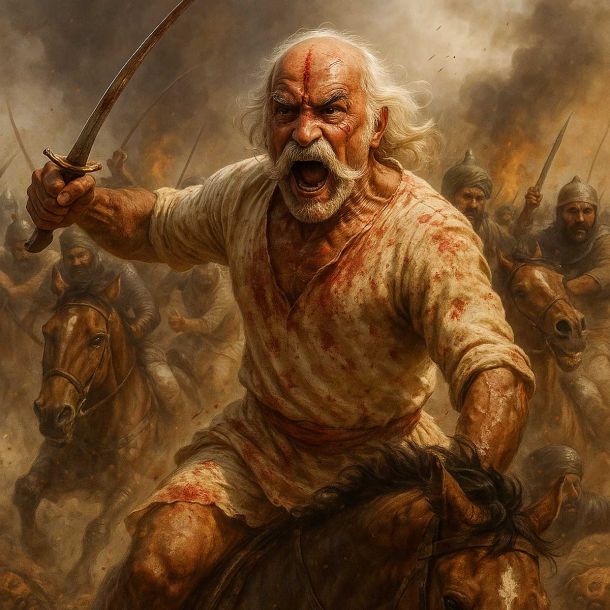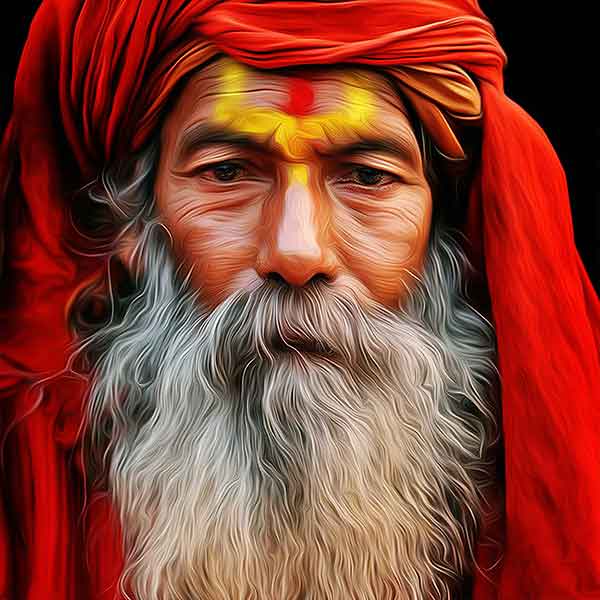Sanatan Articles
Satyaagrah
Written on
Satyaagrah
Written on
Satyaagrah
Written on
Satyaagrah
Written on
Satyaagrah
Written on
JOIN SATYAAGRAH SOCIAL MEDIA
"लुटेरे": From a Rs 248 cr Patiala Necklace to a Rs 1000 cr Jacob Diamond used as a paperweight, India’s royal jewels now lie in foreign hands—Cartier, Christie’s, museums—far from the Maharajas who once wore them with power, pride, and unmatched grandeur

The word Maharaja, which means ‘great king’, brings to mind a vision of power, honor, and stunning beauty. These royal figures were more than just rulers of vast territories—they were cultural icons who celebrated tradition through grandeur. Be it in their clothing, lifestyle, or love for fine craftsmanship, they left behind a legacy of splendor. One of their most admired passions was for jewelry—not just any jewelry, but pieces that dazzled with rubies, sapphires, emeralds, and diamonds.
Each gem was not merely a decoration, but a symbol of pride and power. The carvings, the intricate designs, and the meticulous embellishments created jewels that were more than adornments—they were works of art. Below are six such breathtaking pieces from Indian history that once adorned the majestic figures known as the Maharajas.
|
1. The Patiala Necklace
Few jewels have the aura that surrounds the legendary Patiala Necklace. This one piece alone became a benchmark of luxury and Maharaja elegance. This Indian Maharaja owned a Rs 248 crore Cartier necklace, was the first Indian to buy an aircraft and had a garage full of Rolls Royce cars. His love for luxury went far beyond jewelry. The Maharaja of Patiala’s expensive tastes weren’t limited to his jewels. He was the first Indian to own a private aircraft and his garage was lined with a fleet of Rolls Royce; their numbers were estimated to be somewhere between 27 and 44.
The necklace was created in 1928, commissioned by Maharaja Bhupinder Singh of Patiala, and handcrafted by the iconic jewelry house Cartier. This was no ordinary necklace—it had 2,930 diamonds, including the rare and famous De Beers diamond, also known as the "De Beers Star." Along with that, the necklace shimmered with Burmese rubies, pearls, and emeralds, making it one of the most intricate and luxurious pieces ever designed.
Its origin was steeped in royal rivalry. According to the Cartier archives, when Bhupinder Singh heard that the then maharaja of Kashmir had commissioned a series of priceless items, he wasn’t ready to be outdone. What followed was a monumental move. So he placed the single-largest order Cartier had ever received; sending sealed iron trunks of his royal jewels to Louis Cartier to work his magic.
After three years of craftsmanship, the masterpiece was unveiled—featuring the De Beers yellow diamond (the seventh largest polished diamond in the world which accounts for over 234 carats), 2,900 diamonds adorning the five rows of platinum chains and weighing a total of 962.25 carats.
Sadly, this gem vanished in 1948 after it was last worn by the Maharaja’s son Yadavindra Singh. When it eventually resurfaced decades later, it was incomplete. Decades later, the prized possession resurfaced, but with many of the stones, and the main diamond choker missing from it. Today, Cartier owns it again, having replaced the missing stones with replicas. According to the maison, the Patiala necklace would cost somewhere around $30 million (Rs 248 crore) if it was made today.
|
2. Baroda Diamond Necklace
Next in the line of breathtaking treasures is the Baroda Diamond Necklace, also referred to as the "Star of the South". This necklace represented the rich taste and immense wealth of the Maharaja of Baroda. It was made by Cartier in 1911, and was crowned by a magnificent 128.48-carat diamond at its center. Surrounding it were smaller diamonds, emeralds, and pearls, arranged with such precision that it gave the necklace a graceful and timeless charm.
The Baroda Diamond Necklace embodies the Maharaja's affinity for extravagant jewels and stands as an emblem of his unmatched regal splendour.
Yet, this regal piece too had an interesting journey. It is said that during the 1940’s the necklace was broken to make anklets for Maharani of Baroda, Sita Devi. Sita Devi was no ordinary queen. She was the daughter of the Raja of Pithapuram, and was known worldwide for her grace and flamboyance.
Later, in 1953, she sold those anklets to the famous jeweler Harry Winston. Sita Devi, daughter of the Raja of Pithapuram and former Maharani of Baroda, sold a pair of emerald and diamond anklets to Harry Winston in 1953. Winston then turned them into a necklace for Wallis Simpson, the Duchess of Windsor.
At a 1957 party in New York, the Duchess wore the necklace, where Sita Devi happened to be present. As others admired the dazzling piece, Sita Devi casually commented, "They looked better on my feet." It was a moment that left the Duchess embarrassed—and she soon returned the necklace to Winston.
3. Tiger Eye Turban Ornament
In 1937, Maharaja Digvijaysinhji of Nawanagar made a special request to Cartier. He wanted them to craft a turban ornament using a very rare cognac-colored diamond known as the ‘Tiger Eye’, which had been discovered in 1913. This diamond was fitted into a royal design using baguette-cut diamonds, creating an ornament that reflected traditional Indian style and royal grace.
The Tiger’s Eye, worn on the Maharajah’s turban, was a symbol of immense wealth and prestige. At one time, this Maharaja was counted among "the world's richest men." While most gems in Indian royal collections came from Golconda mines, the Tiger Eye was an exception. Appropriately enough, given its fancy deep orangy-brown colour, it was discovered in the Orange River in South Africa.
The Maharajah purchased it from Cartier, and it is still in its exquisite original platinum-and-diamond setting.
Like many high-end royal jewels, this piece was made to be versatile. Like many other very fine jewels, it is designed to be adaptable: the turban ornament can be split up by removing a frond of diamonds, turning it into a clip brooch. The central setting with the diamond can in turn be unscrewed from the brooch and set into other jewels. But what made this ornament even more unique was its interactive nature. However, there is an an additional, highly unusual feature: the setting can be un-clipped, releasing the diamond completely.
It seems that the Maharajah must have enjoyed taking the diamond out and playing with it. He wore the turban ornament with a plume of pure white egret feathers.
|
4. Aigrette or Sarpech by Cartier
One of the most artistic creations by Cartier was the Aigrette or Sarpech, crafted especially for Maharaja Bhupendra Singh of Patiala. The magnificent front of the aigrette is set with diamonds, rubies and emeralds, and the back has foliate motifs of red, green and blue enamel.
Bhupinder Singh ruled from 1891 to 1938, and was famous for his luxury lifestyle. He wasn’t just a jewelry collector—he was also known for his love of sports, especially cricket, and held important political relationships with the British Raj.
In 1925, he made headlines with a record-setting order. In 1925, he made history by placing the largest single order to Cartier, valued at ₹1,000 million (equivalent to ₹210 billion, US$2.5 billion, or €2.3 billion in 2023), which included various jewelry pieces, among them the Aigrette or Sarpech (Bhupinder Singh of Patiala - Wikipedia).
This was more than a simple order—it was a declaration of modern style blended with Indian legacy. This order was part of his broader passion for collecting jewels, cars, and other luxuries, as noted in his reputation for lavish parties and spending sprees in Europe.
The commission to Cartier was not just a purchase but a statement of wealth and modernity, reflecting the Maharaja's desire to reset his heirloom gems into contemporary designs, particularly influenced by the Art Deco movement popular in the 1920s.
5. The ‘Indore Sapphire’ Taveez Bead Pendant Necklace
One of the lesser-known yet highly personal pieces belonged to Maharaja Yeshwant Rao Holkar II of Indore. Known as the ‘Indore Sapphire’, the jewel weighed 23.20 carats and was later combined with an 18-carat white gold link-chain.
Owned by Maharaja Yeshwant Rao Holkar II of Indore, in the 18th century, it weighed 23.20 carats. An 18carat white gold link-chain was later added to it.
Yeshwant Rao Holkar was a modern Maharaja. He spent a lot of time abroad, especially in Europe and the United States, where one of his homes was located in Santa Ana, California. A lover of the arts, he became a patron of many renowned creatives. One such figure was Man Ray, the avant-garde American photographer based in Paris.
The Paris-based American avant-garde photographer Man Ray photographed Yeshwant Rao Holkar extensively. These informal and intimate images of the maharaja and his wife were probably taken when they were on holiday in Cannes, in the south of France.
|
6. The Star of Asia
This gemstone is one of the finest examples of natural beauty and royal ownership. This was known to be the world’s finest star sapphires, weighing an unbelievable 330 carats with brilliant color, impressive size and sharp star. The Maharajah of Jodhpur owned it and it is said to have originated from Burma.
Known as the Star of Asia, this sapphire is cabochon-cut, giving it a rounded, domed surface. It weighs 330 carats (66 g) and is known for its deep blue-violet color, likely due to the presence of vanadium. At its center, the sapphire displays a distinct six-rayed star, formed by rutile fibers, giving it a magical glow.
It belongs to the corundum mineral class (aluminum oxide), colored by iron, titanium, and vanadium. The cutting process was challenging, requiring precise positioning to maintain the asterism, a testament to expert craftsmanship.
7. Emerald and Diamond Necklace
The elegance of Indian Maharajas was not only reflected in their regal attire and palatial architecture but also in the breathtaking treasures they adorned. Among these, the Emerald and Diamond Necklace created for the Maharaja of Nawanagar stands as a crown jewel of sophistication.
Jacques Cartier made this stunning necklace, set it in an Art deco piece for the Maharaja of Nawanagar in 1926. It featured 17 rectangular emeralds weighing 277 carats. This wasn’t just a necklace—it was a radiant display of balance, design, and luxury, forged during a time when Indian royals were blending Eastern traditions with Western finesse.
The Maharaja of Nawanagar (present day Jamnagar in Gujarat) possessed a magnificent emerald and diamond necklace made from 17 rectangle-shaped emeralds weighing 277 carats. The most magnificent emerald of the set weighed 70 carats and was said to have once belonged to a Sultan of Turkey, adding further richness to its legacy.
This necklace, like many prized heirlooms of royalty, journeyed across time and continents. Over the years, the emerald changed hands several times, eventually ending up in the possession of Harry Winston. In 1959, Winston purchased a collection of 17 emeralds from the Maharaja of Nawanagar, six of which were used to create a necklace that included the Sultan's emerald. These stones, layered in history, became part of a modern masterpiece once again, speaking to the eternal bond between Indian royalty and legendary jewelers like Cartier and Winston.
|
8. Sprays of Flowers Turban Jewel
Few ornaments capture the soul of Indian artistry as vividly as turban jewels. Among them, the Sprays of Flowers Turban Jewel of the Maharaja of Jaipur stands out with grace and uniqueness.
Once owned by the Maharaja of Jaipur, the aigrette features emeralds, rubies and pale beryl on one side. The other side had the same stones with the addition of diamonds. The stem and the sides of the jewel were enameled with translucent green.
More than just a display of riches, this piece is an example of rare artistry where Mughal influence meets Rajasthani craftsmanship. Sprays of flowers are commonplace in Mughal art, but it is rare to find an Indian turban jewel reproducing the characteristic border motif of countless textiles, miniatures and metal artefacts.
This jeweled aigrette was one of several collected by the Victoria & Albert Museum (V&A) in the early 1920s. This jewelled gold ornament for the male turban is one of an important group of other turban jewels bought by the V&A in 1922 and 1923 from a Mr Talyarkhan, who had purchased them from the Maharaja of Jaipur.
There was initial speculation about its origin. The vendor seems to have suggested that this was an imperial Mughal jewel which had been presented to Jaipur by an 18th century Mughal emperor. However, the artwork more closely resembles Rajasthani aesthetics. Similar forms are seen in 18th century paintings of Rajasthani rulers and it seems perhaps more likely that this example was made in Rajasthan. On closer view, the aigrette is set with rubies, emeralds and pale beryls on one side, and the same stones with the addition of diamonds on the other. The stem and the sides of the jewel are enamelled in translucent green.
It’s not just a jewel—it’s an heirloom echoing the floral stories of Indian textiles in metal, stone, and enamel.
9. The Nizam of Hyderabad's Jewelry Collection
If the Maharajas of India were symbols of power, the Nizams of Hyderabad were monuments of wealth. Their treasure chests were overflowing with gems that stunned the world.
The Nizams of Hyderabad were renowned for their unparalleled wealth and extravagant lifestyles. Their jewelry collection was no exception. The most jaw-dropping piece from their vaults was the Jacob Diamond, an incredible 184.75-carat diamond that once rested on the turban of the sixth Nizam, Mahbub Ali Khan. Another iconic ornament was the "Hussain Sagar" diamond necklace, known for its 65-carat diamond pendant.
These breathtaking pieces exemplify the Nizams' penchant for extraordinary gemstones and the exceptional craftsmanship of their artisans.
Their riches were legendary, sometimes even used with humor. This Nizam used a Rs 1000 Cr diamond as paperweight, owned 50 Rolls-Royce cars & had Rs 19 lakh crore of net worth.
In 1937, the world acknowledged this splendor when Mir Osman Ali Khan, the seventh Nizam, appeared on the cover of TIME magazine. It called the seventh Nizam of Hyderabad the “richest man on the planet”, considering his net worth in the early ‘40s was approximately $236 billion (Rs 18 lakh 68 thousand Crores), according to The Business Standard.
His car collection rivaled the wealth of nations. His garage was a motorhead’s paradise, with (at least) 50 Rolls-Royce cars, including the highly coveted Silver Ghost Throne Car.
Though his power was curtailed after Hyderabad’s annexation in 1948, Mir Osman Ali Khan was the last to hold the title of Nizam in its true sense. Following Hyderabad’s annexation in 1948, he was forced to abdicate. Still, he served as the state’s Rajpramukh (governor).
|
10. The Indore Pears
When royalty meets avant-garde fashion, the result is timeless. One such story is of the Maharani of Indore, whose jewelry collection came to represent elegance, independence, and vision.
The Maharani of Indore, a progressive and fashion-forward leader, possessed a unique sense of style that extended to her jewelry collection. She was the owner of the famed Indore Pears—a dazzling pair of pear-shaped diamonds, each transformed into a necklace, tiara, brooches, and earrings.
Known as the "Indore Pears," her collection featured a set of exquisite pear-shaped diamonds. These stunning jewels were transformed into a necklace, tiara, brooches, and earrings, showcasing the Maharani's distinctive taste and penchant for avant-garde designs.
These diamonds weren’t just accessories—they were expressions of a woman ahead of her time. The Indore Pears symbolise Maharani's trailblazing personality and have become an emblem of her fashion legacy.
Their origin lies with Tukoji Rao Holkar III, Maharaja of Indore. It begins with Tukoji Rao Holkar III, Maharaja of Indore. In October 1913, while visiting Europe, Tukoji Rao Holkar III went to French jeweler Chaumet’s Paris Salon to purchase a jewel for his new wife, who he had only married that year. There, he was presented with two stunning diamonds. Chaumet showed him two unbelievable pear-shaped diamonds weighing 46.70 and 46.95 carats, later known as the Indore Pears.
The jeweler also provided design suggestions. Chaumet also shared possible designs, including a sketch of a sleek necklace in the French Lavalier style. The price? Quite princely. At the time, including the diamonds, it cost over 631,000 Francs (approximately USD 268,000). After taking some time to decide, Tukoji returned the next day to commission the necklace containing the two remarkable natural diamonds, which was shipped to him a few weeks later. It was the first time the diamonds were mounted in jewelry.
11. The Nawanagar Ruby Necklace
Few pieces have traveled through time with as much royalty and glamour as the Nawanagar Ruby Necklace, also known as the Jodhpur Ruby Necklace. Commissioned by Maharaja Digvijaysinhji of Nawanagar in 1937, it was a breathtaking mix of Indian regal tradition and Western luxury design.
The Nawanagar Ruby Necklace, also known as the Jodhpur Ruby Necklace, stands as an exquisite masterpiece that exemplifies the opulence of Indian royalty and the artistry of Cartier.
Its heart was a 158.6-carat Burmese ruby, encircled by brilliant diamonds and set in platinum. Commissioned in 1937 by Maharaja Digvijaysinhji of Nawanagar, this stunning piece features a breathtaking 158.6-carat Burmese ruby surrounded by dazzling diamonds, elegantly set in platinum.
Designed by Jacques Cartier, this necklace brought together two great worlds. Designed by none other than Jacques Cartier himself, the necklace is a harmonious blend of traditional Indian craftsmanship and Cartier's unrivaled expertise. Worn by royalty and loved by collectors, it became a symbol of lasting legacy.
Its history is laced with tales of grandeur, having adorned the neck of a Maharaja. Today, the Nawanagar Ruby Necklace serves as a symbol of timeless beauty and cultural heritage, captivating jewelry enthusiasts and historians alike.
Its fame continued beyond royal courts. This iconic piece of jewelry soon made headlines again when Mrs. Guinness wore it to Truman Capote's famous Black and White Ball in 1966.
Today, it is part of the revered Al Thani Collection. Today, the necklace is part of the prestigious Al Thani collection, and it was first displayed at the Grand Palais exhibition "Magnificent Mughals to Maharajas."
|
12. The Baroda Pearls
There are some jewels that don’t just shine—they define an era. The Baroda Pearls, once part of the treasured possessions of the Maharani of Baroda, were among such legendary adornments. Known for her distinctive style and commanding presence, she was a fashion icon in royal circles.
The Maharani of Baroda was a trendsetter in the world of fashion and style, and her collection of pearls was nothing short of extraordinary. Her jewel box held many marvels, but the one that stood out was the Baroda Pearl Necklace. Among her treasures, the renowned "Baroda Pearl Necklace" stands out. Comprising seven strands of lustrous pearls, this necklace was adorned with a remarkable pendant featuring the Empress Eugenie diamond.
The image of the Maharani, draped in this masterpiece, left a permanent impression of class and opulence. The elegance and grace of the Baroda Pearls epitomise the Maharani's passion for pearls and serve as a testament to her sartorial finesse.
These pearls weren't just chosen for beauty—they had heritage. The Baroda pearls have a rich history dating back several centuries. These pearls are named after the city of Baroda (now Vadodara) in the western state of Gujarat, India. The city itself was a pearl of the subcontinent, recognized for its thriving trade in precious objects. Baroda was known as a hub for pearl trading and production, and the Baroda pearls gained fame for their exceptional quality and beauty.
Each strand was a thread to the past, a whisper of regal traditions passed from one queen to another—bearing witness to India’s royal opulence.
13. The Arcot II Diamond
Diamonds have long traveled with kings, queens, and conquerors. The Arcot II Diamond is one such timeless stone—a sparkling legacy from Tamil Nadu that crossed borders and thrones.
The Arcot II Diamond is a legendary jewel associated with the Nawabs of Arcot in Tamil Nadu. This extraordinary gem, weighing approximately 38.4 carats, boasts a rare blue colour and exceptional clarity.
Its story takes us back to a time when Indian royals used diplomacy through brilliance. The Kohinoor was not the only extraordinary diamond to leave India. Native rulers, either caught in a show of one-upmanship or keen on currying favour with the British, often sent stunning gifts to the British Crown. One of the most generous and strategic rulers was Nawab Mohammad Ali Khan Wallajah of Arcot, who ruled from 1752 to 1795.
Among those best known for their lavish flow of gifts to the King and Queen of England, was the Nawab of Arcot, Mohammad Ali Khan Wallajah who reigned from 1752-1795. Among his prized gifts to Queen Charlotte, the wife of King George III, were two magnificent diamonds—Arcot I and Arcot II.
Part of the nawab’s many gifts to Queen Charlotte, the wife and consort of King George III, were two pear-shaped and brilliant gems known as the Arcot I & Arcot II diamonds. These diamonds, once belonging to Indian royalty, found new meaning in European courts. But after Queen Charlotte’s passing, the diamonds were separated. The Arcot diamonds were sold separately after the death of Queen Charlotte.
In its next chapter, The Arcot II, lightly recut and weighing 17.21 carats, was part of the Al Thani collection before being sold at an auction at Christie’s in 2019 for a staggering $3,375,000.
It stands today not just as a jewel, but as a bridge—a symbol of the strong ties between the British Empire and the princely states of India, and its captivating beauty continues to mesmerise enthusiasts worldwide.
|
The Jaipur Gem Palace Collection
Nestled in the vibrant city of Jaipur, the Gem Palace is more than a jewelry store—it is a time capsule of India's regal heritage. For over two centuries, this legendary establishment has safeguarded treasures crafted for kings, queens, and global dignitaries.
The Jaipur Gem Palace houses a remarkable collection of Maharaja jewelry that spans centuries of regal history. Each piece is a story in stone—crafted with purpose, artistry, and royal flair. This treasure trove showcases a diverse range of exquisite pieces, including intricately crafted necklaces, bracelets, earrings, and turban ornaments.
Among its highlights is the enchanting Kundan Meena jewelry—a traditional Indian technique that brings color and brilliance together. Notable highlights include the Kundan Meena jewelry, featuring a fusion of refined enamel work and meticulously set gemstones.
The collection is not merely a gallery of jewels—it is living proof of the royalty's timeless love for creativity and detail. The Jaipur Gem Palace Collection serves as a testament to the enduring legacy of the Maharajas of Jaipur and their patronage of exceptional craftsmanship.
Its legacy is as long as its jewels are bright. The Jaipur Gem Palace Collection has a fascinating history that spans several generations and is closely intertwined with the city of Jaipur, located in the state of Rajasthan, India. Over 200 years of operation has made the Gem Palace not just a shop, but a guardian of royal elegance. The collection is associated with the renowned Gem Palace, a jewelry store that has been in operation for over two centuries.
Legacy of Indian Maharaja Jewelry
The world of Maharaja jewelry remains an awe-inspiring domain—a place where beauty meets legacy, and craftsmanship echoes through the ages.
The world of Maharaja jewelry is an enchanting realm where opulence and artistic brilliance intertwine. Each piece described above—from the Patiala Necklace to the Nawanagar Ruby Necklace—is more than just a jewel. It is a royal signature, capturing moments of India's golden history.
The legendary pieces mentioned above are just a glimpse into the vast treasure troves of Indian royalty. From the Patiala Necklace's unparalleled grandeur to the Nizam of Hyderabad's breathtaking diamonds, each jewel tells a story of regal magnificence and the rich cultural heritage of India.
What these jewels continue to evoke is not just luxury, but the human spirit behind their creation—the rulers who commissioned them, the artists who shaped them, and the legacy they passed on. These iconic pieces continue to inspire awe and fascination, representing the legacy of the Maharajas and their unwavering pursuit of beauty and luxury.
Even today, as they sparkle in global exhibitions or private collections, they carry the soul of a time when India glowed under the patronage of kings and queens. As we marvel at their beauty, we pay homage to the exceptional craftsmanship and timeless allure of Maharaja jewelry, a treasure trove of opulence that has captivated the world for centuries.
 |
 Support Us
Support Us
Satyagraha was born from the heart of our land, with an undying aim to unveil the true essence of Bharat. It seeks to illuminate the hidden tales of our valiant freedom fighters and the rich chronicles that haven't yet sung their complete melody in the mainstream.
While platforms like NDTV and 'The Wire' effortlessly garner funds under the banner of safeguarding democracy, we at Satyagraha walk a different path. Our strength and resonance come from you. In this journey to weave a stronger Bharat, every little contribution amplifies our voice. Let's come together, contribute as you can, and champion the true spirit of our nation.
 |  |  |
| ICICI Bank of Satyaagrah | Razorpay Bank of Satyaagrah | PayPal Bank of Satyaagrah - For International Payments |
If all above doesn't work, then try the LINK below:
Please share the article on other platforms
DISCLAIMER: The author is solely responsible for the views expressed in this article. The author carries the responsibility for citing and/or licensing of images utilized within the text. The website also frequently uses non-commercial images for representational purposes only in line with the article. We are not responsible for the authenticity of such images. If some images have a copyright issue, we request the person/entity to contact us at This email address is being protected from spambots. You need JavaScript enabled to view it. and we will take the necessary actions to resolve the issue.
Related Articles
- Assam King Prithu who badly defeated Bakhtiyar Khilji, destroyer of Nalanda University in Battle of Kamrup in 1206 CE
- Unsung Heroine Pritilata Waddedar, Who Shook The British Raj at the age of 21
- Tirot Singh: An Unsung Hero of the Khasi Tribe who destroyed British with his skill at Guerrilla Warfare
- With Lord Mountbatten & Edwina's 'bed-hopping' marriage - gay brothels and affair with PM, British historian Andrew Lownie reveals it all
- Srivijaya, 1400 years older than Port Blair, honors a Buddhist kingdom in Sumatra & Rajendra Chola’s epic naval war, a tribute to his vision that expanded Indian influence across Southeast Asia using monsoon winds and maritime routes, a true global power
- Kartar Singh Sarabha - The Freedom fighter who was Hanged at the age of 19 and inspired Bhagat Singh
- Freedom struggle of Gurjars against Britishers at Koonja in 1824: 100s of Gurjars Martyred and 100s Hung in Single Tree
- 16 year old freedom fighter Shivdevi Tomar, who killed 17 Britishers and wounded many
- Father of the Nation! Absolutely not. Mohandas Karamchand Gandhi was not the father of the nation either officially or otherwise
- Vinayak Damodar Savarkar – A Misunderstood Legacy
- "Uncover a hidden aspect of history": The mystery surrounding King Vikramaditya's reign and his illustrious Navaratnas, journey through time, exploring the legends of Kalidasa to Vetala Bhatta, unraveling a historical enigma from the 1st century BCE
- Pt. Madan Mohan Malaviya’s independent ‘Note’ to the Industrial Commission of 1916: India’s Industrial Heritage
- Birth, Parentage and Early Environment - An Indian Pilgrim (Netaji's Life and writings)
- Winston Churchill's hate for Indians caused millions of deaths: A villainous supremacist
- The perpetrator of the Jallianwala Bagh massacre General Reginald Dyer was forgiven by Mohandas Gandhi as an exercise of forgiveness or love to nurse Dyer back to life if he was suffering from a physical malady





















